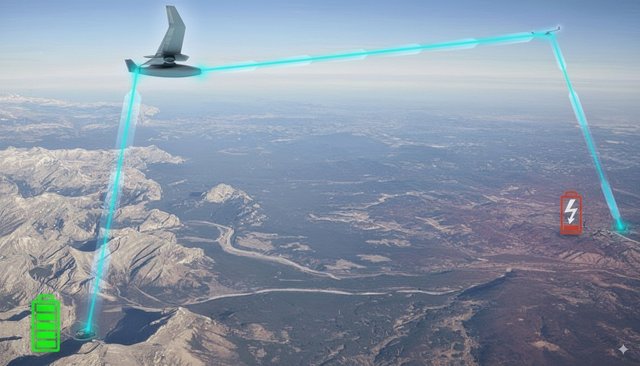DARPA’s POWER Program: Pioneering the Future of Wireless Energy Transmission
How Laser-Based Wireless Power Could Transform Drones, Disaster Relief, and Remote Operations
DARPA’s Persistent Optical Wireless Energy Relay (POWER) program has made a groundbreaking advancement in wireless energy technology. For the first time, researchers successfully transmitted over 800 watts of electricity across 8.6 kilometers (5.3 miles) using a high-precision laser. This achievement marks a significant step toward wire-free power delivery, especially in remote and challenging environments.
DARPA’s Vision: Wireless Energy Without Limits
The POWER program aims to redefine energy transmission. Traditional copper-based infrastructure has limitations, particularly in areas where installing or repairing power lines is difficult or impossible. The POWER system converts electricity into a focused laser beam, which is then transmitted through the air to a specialized receiver. At the receiving end, photovoltaic cells convert the laser light back into usable electricity. This method is similar to a "Wi-Fi network for power," allowing precise and efficient energy delivery without physical cables.
How the Technology Operates
DARPA’s system operates in three key stages:
- Electricity to Laser Conversion: Electrical power is transformed into a high-intensity laser beam.
- Airborne Transmission: The laser travels through the atmosphere to its target with minimal energy loss.
- Laser to Electricity Conversion: The receiver captures the laser light and converts it back into electricity.
This process offers a solution where traditional electrical infrastructure is impractical or too costly.
Real-World Applications
The applications of wireless energy are diverse and potentially transformative:
Drones and UAVs: Wireless power allows drones to stay aloft for extended periods without landing to recharge, enabling longer missions and increased operational efficiency.
Disaster Response: Emergency teams can restore power to critical systems in disaster-stricken areas without relying on damaged infrastructure.
Remote Sensors and Research Stations: Continuous wireless power can keep remote monitoring equipment operational, supporting research in extreme or inaccessible locations.
Military Operations: Forward bases in remote areas can benefit from reliable energy without depending on fuel convoys or vulnerable power lines.
High-Altitude and Space Applications: Future adaptations could transmit power from satellites or high-altitude platforms to ground stations.
Challenges to Overcome
Despite its potential, the POWER system faces challenges:
Atmospheric Conditions: Fog, haze, and dust can reduce laser efficiency.
Conversion Efficiency: Some energy is lost in converting electricity to laser and back.
Safety Concerns: High-power lasers require strict safety protocols.
Scalability: Expanding the system for larger energy loads needs advanced infrastructure and innovation.
The Future of Wireless Energy
DARPA plans to integrate airborne relay pods that catch and relay laser beams, enabling multi-hop energy transmission over distances up to 200 kilometers. This could power drones, remote bases, and critical equipment without traditional grids. In commercial and smart city applications, wireless power could supply energy to IoT devices, streetlights, and delivery drones efficiently.
SEO and Visibility Considerations for Steemit
For Steemit, using keywords naturally throughout the article will enhance discoverability. Suggested terms include "DARPA wireless power," "POWER program laser energy," "wireless electricity transmission," "remote energy solutions," and "drone wireless charging." Engaging, informative content with clear explanations and real-world applications will attract readers and encourage shares.
Conclusion
DARPA’s POWER program represents a leap forward in wireless energy technology. By transmitting electricity over 8.6 kilometers without wires, it showcases the potential to revolutionize power delivery for drones, emergency response, and remote operations. As this technology evolves, we may see a world where electricity can be transmitted as seamlessly as data, transforming how we power devices in even the most challenging environments.
